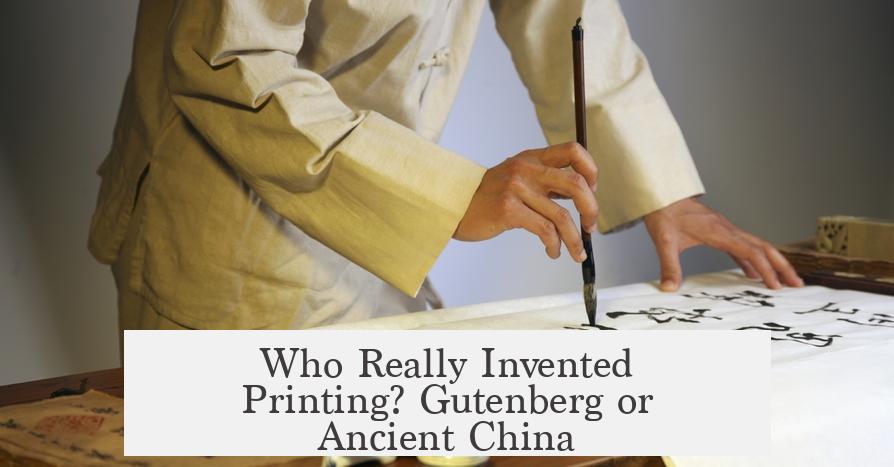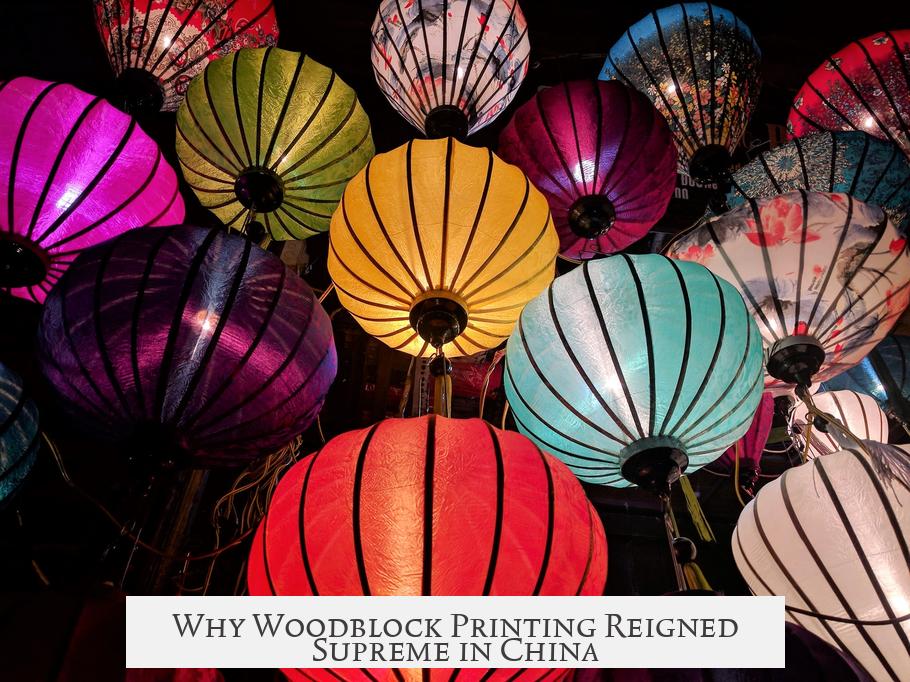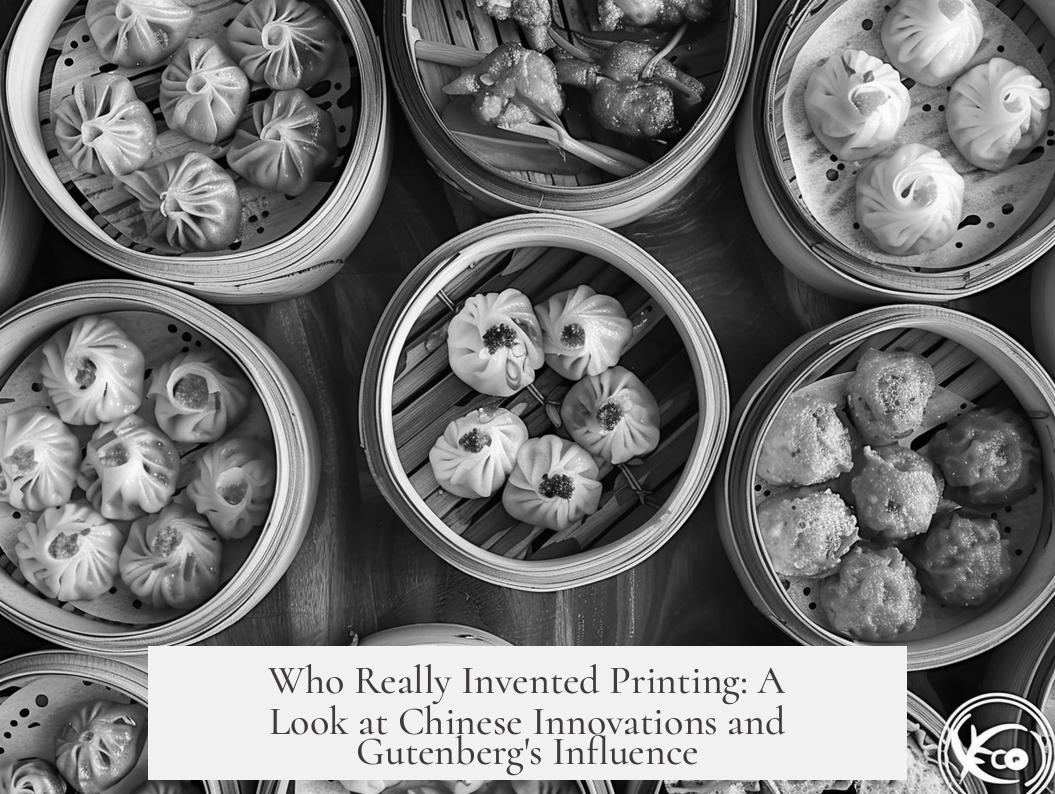While Johannes Gutenberg is widely credited with inventing the movable type printing press in Europe around 1440, the Chinese had already developed various forms of printing centuries earlier. This includes woodblock printing from the Tang dynasty and movable type invented by Bi Sheng during the Song dynasty, demonstrating a rich, pre-existing Chinese print culture long before Gutenberg’s press.
Printing technology in China dates back to the Tang dynasty (618–907). The exact origin of woodblock printing is debated, but surviving examples such as Buddhist sutras from the 8th century, made during Empress Wu Zetian’s reign, provide strong evidence of its early use. These were often religious texts and mark some of the earliest forms of printed materials.
By the 9th century, printing diversified significantly. Calendars from 877 and 882 excavated in Dunhuang reflect the broadening scope of printed content. Officials like Liu Pian recorded books on astrology, geomancy, lexicography, and divination printed in Sichuan around 883. Tang dynasty works on alchemy and other subjects were mass-produced.
During the Five Dynasties period (907–960), cultural and literary works including Taoist commentaries and Confucian classics began to be printed systematically. The earliest printed Taoist text dates from 913, while Confucian classics were printed by 953 under government supervision, illustrating the role of printing in disseminating official knowledge.
The Song dynasty expanded the printing industry further, with nearly 200 production sites by the Southern Song period (1127–1279). These centers produced books across many topics, including medicine, agriculture, mathematics, literature, philosophy, and more. This wide availability contributed to a vibrant print culture and public access to knowledge.
Most notably, movable type printing was invented in China before Gutenberg. Bi Sheng, in the 11th century Song dynasty, created the earliest known movable type using baked clay. Though this invention did not revolutionize printing as Gutenberg’s press did in Europe, it marked a key technological advance. Wang Zhen later improved on this by developing wooden movable type and mechanical techniques to speed up typesetting.
Late in the Ming dynasty (around the late 15th century), metal movable type printing began to appear, coinciding roughly with Gutenberg’s work in Europe. However, Chinese printing continued to rely heavily on woodblock printing, which remained more practical for the Chinese language and market realities.
The complexity of Chinese characters, numbering in thousands, made movable type less efficient and more costly compared to alphabetic systems. Woodblock printing required carving entire pages but had advantages: block carvers did not need literacy, reducing labor skill requirements. The engraved blocks could print many copies with limited additional effort.
Additionally, movable type printing required a massive collection of characters for typesetting, increasing costs and limiting its use primarily to expensive government publications. Woodblock printing’s lower initial investment and ease of repeated use sustained its popularity.
Specific uses of movable type printing in China existed, notably for genealogy books. These featured repetitive characters, making movable type more practical. Even then, genealogies during the Qing dynasty showed a diverse mix of printing methods—block prints, manuscripts, and movable type—indicating movable type remained a niche technique.
| Printing Method | Characteristics | Use Cases |
|---|---|---|
| Woodblock Printing | Carving entire pages on wooden blocks; repeated use; no literacy needed for carvers; low ongoing cost | Broad range of books, calendars, religious texts, official documents |
| Movable Type Printing (Clay/Wood/Metal) | Individual characters movable; higher initial cost; requires literacy and complex materials | Government publications, genealogies, specialized uses |
Technologically, Chinese printing involved applying ink by brushing paper laid over the type, unlike Gutenberg’s screw press which pressed inked type onto paper more efficiently. The Roman alphabet’s limited character set lent itself well to movable type, while the vast complexity of Chinese script presented unique challenges that slowed movable type adoption.
In sum, Gutenberg did not invent printing itself but revolutionized movable type printing and the printing press in a European context. Chinese woodblock printing predates Gutenberg by hundreds of years, while Chinese movable type predates his press by about four centuries. Each culture developed printing suited to its language, needs, and technological context.
- Woodblock printing originated in China by the Tang dynasty (618–907), producing varied printed materials centuries before Gutenberg.
- Movable type printing was invented by Bi Sheng in the 11th century, centuries before Gutenberg’s press in the 15th century.
- Woodblock printing remained dominant in China due to character complexity and cost issues with movable type.
- Genealogy printing was a notable niche where movable type saw increased use.
- Gutenberg’s press innovated with metal movable type and screw press technology tailored to the Roman alphabet.
Who Really Invented Printing? Gutenberg or Ancient China?

So, was Gutenberg the sole inventor of printing, or does China hold an earlier claim? The answer is both fascinating and complex: Chinese printing culture predates Gutenberg’s invention by centuries, notably through woodblock printing and even movable type. This might surprise anyone who grew up with the simple story that Johannes Gutenberg, a 15th-century German goldsmith, “invented printing” from scratch. Turns out, Chinese innovations in printing had already set the stage long before Gutenberg’s press ever rolled out.
Strap in! We’re about to journey through history scholars often breeze past, uncovering how China’s distinct printing methods carved their own path to shaping literature and culture — and how Gutenberg fit into that saga.
Woodblock Printing: China’s Pioneering Print Culture
The story kicks off back in the Tang dynasty (618–907). Historians mark this era as when woodblock printing came into its own. Imagine mind-bogglingly intricate wooden blocks covered with reverse text and images. These could be inked and pressed onto paper repeatedly to create numerous copies. The earliest surviving prints? 8th-century Buddhist sutras — ancient religious texts carved to preserve knowledge.
Woodblock printing wasn’t just for monks. By the 9th century, printed works branched out to calendars, alchemy manuals, astrology, and more. Officials like Liu Pian witnessed books covering everything from divination to lexicography being churned out in bustling printing centers across Sichuan and beyond.
During the chaotic Five Dynasties period (907–960), printing centers sprouted in major cities like Luoyang and Hangzhou, printing Taoist and Confucian texts. It’s clear that print culture wasn’t a niche religious hobby — it was deeply embedded in Chinese society and knowledge dissemination.
Peak Printing: The Song Dynasty Explosion
The Song dynasty (960–1279) really cranked printing into overdrive. Imagine going from 30 locations making printed books in the Northern Song to nearly 200 in the Southern Song — all despite losing territory to invading Jurchens.
Books covering medicine, agriculture, novels, geography, philosophy, and literary collections flooded markets, supported by government sponsorship and a surging commercial book industry. Chinese citizens suddenly had access to a wealth of knowledge, much of it printed via this time-tested woodblock method.
Movable Type Invented First in China—Not Gutenberg
This one may rattle some history books: the first known movable type came from China, invented by Bi Sheng in the Song dynasty, about 400 years before Gutenberg. What exactly was Bi Sheng’s contribution? He crafted movable type out of earthenware (think clay characters you can arrange and rearrange for printing).
Later, Wang Zhen improved the game with wooden movable type and mechanical innovations that sped up typesetting. This wasn’t just a few fancy letters on blocks; it was a technological leap forward, tested and refined centuries before Europe tried the idea.
That said, movable type printing remained quite limited in China initially. Why? The complexity and cost of producing types for thousands of characters bogged down private printers. Governments mostly funded these projects, so print culture flourished mainly through woodblock printing, which proved cheaper and more practical.
Why Woodblock Printing Reigned Supreme in China

Here’s a nugget of insight: woodblock printing dominated because it was practical. Carving a block didn’t require literacy; artisans carved around characters without understanding them. This made production easier and less dependent on specialized skills.
Moreover, reusable blocks meant repeat print runs came at low extra cost. Movable type needed someone who at least knew the alphabet—or in the case of Chinese characters, thousands of them! Plus, creating metal type was technically demanding and expensive.
Hence, woodblock printing was king—ultra efficient for the diverse, rapid production of text and images people craved.
Gutenberg and the Western Printing Press: How Was It Different?
Fast forward to mid-15th century Europe. Johannes Gutenberg didn’t just copy Asian movable type; he reinvented and transformed printing in a distinct context.
Europe used an alphabet with fewer characters, making movable type far easier and cheaper to produce. Gutenberg’s breakthrough was in creating a robust, durable metal type and pairing it with a screw press — a more efficient, mechanical way to transfer ink onto paper. This was a game-changer for Western print culture and the mass production of books.
Contrast this with Chinese movable type, which involved pressing paper onto inked type by brushing, a slower, less mechanized task. So Gutenberg’s press excelled in speed and efficiency, igniting a printing revolution in Europe and fueling a surge in literacy and knowledge sharing.
Niche Applications of Movable Type in China
Despite woodblock printing’s dominance, movable type found niche uses — especially printing genealogies with their limited, repeating characters. Studies show Qing dynasty genealogies passed through block prints (58%), manuscripts (34%), and wooden or lead type (18%).
In other words, movable type did exist and served specific purposes but didn’t replace woodblock printing wholesale. It’s like having a sports car and a reliable truck — each suited certain tasks.
What Does All This Mean for the “Who Invented Printing?” Debate?
Both perspectives your schoolteacher and your Chinese friend offer hold truth:
- China invented woodblock printing and the earliest movable type centuries before Gutenberg.
- Gutenberg independently revolutionized printing in Europe with metal movable type and a press mechanism suited to the Roman alphabet.
The real marvel is how these innovations sprang from different cultural needs and solved distinct problems. China’s complex script favored woodblock methods, while Europe’s alphabet benefited from movable metal type and presses, which then accelerated the knowledge explosion of the Renaissance.
Fun Fact: Gutenberg’s Influence Didn’t Stop at the Press

His printing press wasn’t just about mechanics; it fomented an information revolution. Printed books made ideas accessible, laying groundwork for the Reformation, scientific advancements, and modern education. So while China had printing first, Gutenberg’s contribution catalyzed massive cultural change in his context.
Tips for Appreciating the Full History of Printing
- Celebrate both Chinese and European innovations. Each advanced printing in ways suited to their language and society.
- Consider the role of linguistic complexity. Chinese script complexity changed printing’s economics and technology.
- Look beyond a single “inventor.” Technological progress often builds worldwide, across centuries.
Final Thoughts
So next time someone says “Gutenberg invented printing,” ask: “Which printing?” Because history shows that China’s woodblock and movable type printing invented the concept long before Gutenberg. Then, Gutenberg amplified and refined it for his world, creating something uniquely transformative.
Recognizing this rich, interwoven history enriches how we see technology, culture, and knowledge—reminding us that no invention emerges in isolation. It’s teamwork, but on a global stage across time.
“In the world of printing, both Chinese woodblocks and Gutenberg’s metal types wrote chapters in humanity’s story—each indispensable to the narrative of knowledge sharing.”
Did printing exist in China before Gutenberg’s invention?
Yes. China developed woodblock printing centuries before Gutenberg. The earliest surviving block prints date back to the Tang dynasty (618–907). This form of printing spread widely by the Song dynasty.
Who invented movable type printing first, Bi Sheng or Gutenberg?
Bi Sheng invented the earliest movable type printing in China around the 11th century, about 400 years before Gutenberg’s press. He used earthenware type, while Gutenberg improved the technology with metal movable type and a screw press.
Why was woodblock printing more popular than movable type in China?
Woodblock printing was cheaper and easier because thousands of Chinese characters made movable type costly. Block carvers didn’t need to read, and blocks could be reused many times. Movable type was mainly used for official or repetitive texts like genealogies.
How was Chinese movable type printing different from Gutenberg’s printing press?
Chinese movable type involved inking the type and brushing paper on top, unlike Gutenberg’s press that used a screw mechanism for efficient pressing. Also, Chinese printing managed thousands of characters, which added complexity compared to alphabetic printing.
Did Chinese printing technology influence Gutenberg’s invention?
There is no clear evidence that Gutenberg’s printing press was directly influenced by Chinese printing. Both developed independently, adapting to different languages and technologies suited to their regions.




